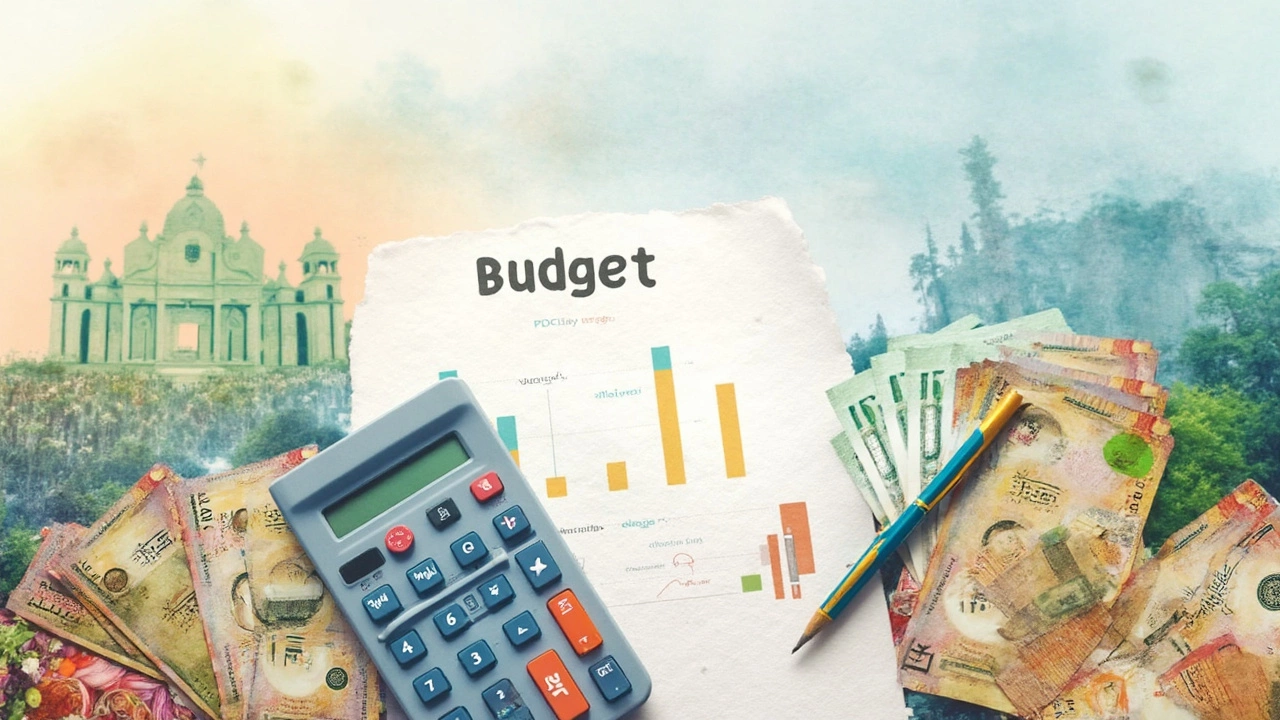
Thinking about how much cash you'll need to make it in India? It's not just about the numbers but about living a life that's comfortable for you and your family. So, let's break down the essentials: housing, groceries, bills, and a bit for fun and savings, ‘cause who likes living just paycheck to paycheck anyway?
First things first, let's talk about where you live. Cities like Mumbai and Bangalore can be pricey when it comes to rent, but places like Jaipur or Lucknow might just surprise you with their affordability. Keep in mind, it's more than just rent—think utility bills, internet, and maybe even a maid service if that's your thing.
- Basic Living Expenses
- Housing Costs Across Cities
- Everyday Necessities and Bills
- Saving for the Future
- Managing Lifestyle Choices
Basic Living Expenses
So, when we're talking about basic living expenses in India, we’re diving into the essentials that keep things running smoothly every day. This includes stuff like rent, groceries, utilities, and transportation. Exactly how much you need can vary—quite a bit, actually—depending on where you are and how you like to live.
Let's break it down, starting with food and groceries. If you're in a city like Delhi or Mumbai, expect to spend somewhere around INR 5,000 to 8,000 a month per person on groceries if you're cooking at home. This amount covers staples like rice, lentils, and vegetables, plus a few extras like snacks and personal care items. Eating out? It can be cheap if you're sticking to local food, but international cuisine or frequent dining in upscale places will need more budget.
Next up, transportation. If you're using public transport like Metro, buses, or local trains, it's pretty cheap. For example, in Delhi, a Metro card that gets you around for a whole month costs around INR 1,500. But if you own a vehicle, factor in the cost of fuel, maintenance, and insurance, which can add up quickly.
Utility bills are another must-consider. On average, expect to pay about INR 2,000 to 4,000 a month for electricity, water, and gas. If you love your AC during summers, be prepared for that number to rise.
Here's a quick look at some typical monthly costs:
| Expense | Estimated Monthly Cost (INR) |
|---|---|
| Rent (1 BHK in city center) | 10,000 - 25,000 |
| Groceries | 5,000 - 8,000 |
| Transportation (public) | 1,000 - 2,000 |
| Utilities | 2,000 - 4,000 |
| Mobile and Internet | 1,000 - 1,500 |
Of course, these numbers can change based on your city, lifestyle, and habits. But having a rough idea helps in planning and making sure you have enough to cover your essentials. Balancing these basics with your lifestyle choices is key to managing your cost of living in India effectively.
Housing Costs Across Cities
The first big thing you'll deal with when setting up life in India is housing costs. It’s a mixed bag because it hugely depends on which city you park yourself in. In cities like Mumbai, the financial heart, you might be looking at quite a hefty chunk of change for rent. A one-bedroom apartment in the city center might set you back around INR 50,000. But if you shift towards the outskirts, you might snag something around INR 25,000.
Bangalore is another story. Known as the Silicon Valley of India, it's a magnet for IT pros. Here, a similar apartment might cost you about INR 35,000 in the city center and about INR 15,000 if you're okay with being on the outer ring.
However, if your work or lifestyle takes you to a less hectic place like Jaipur or Lucknow, you'll find housing surprisingly wallet-friendly. Imagine scooping up an apartment right in the middle of things for about INR 15,000, and if you’re moving towards the suburbs, it drops lower.
| City | City Center Rent (1BHK) | Suburbs Rent (1BHK) |
|---|---|---|
| Mumbai | INR 50,000 | INR 25,000 |
| Bangalore | INR 35,000 | INR 15,000 |
| Jaipur | INR 15,000 | INR 10,000 |
| Lucknow | INR 15,000 | INR 8,000 |
Remember, with living expenses it’s also about quality. Some places like Gurgaon offer pricey rents but come with perks like modern facilities and good schooling nearby. Meanwhile, towns like Coimbatore might be kinder to your budget and still provide a great living experience, blending urban with a dash of tradition.
Being smart about housing can make all the difference. Whether you're solo, with a partner, or moving the whole family, knowing where the hidden gems are, and which places are on the rise, can help make managing your budget in India much smoother.

Everyday Necessities and Bills
Living in India means juggling a mix of everyday costs. Let's dive into the major things that make up your monthly expenses beyond just rent. Understanding these will help you see how much you might need to live comfortably.
First off, food. Eating out is fun, but groceries are what you'll be dealing with most of the time. On average, a small family might spend around INR 5,000 to 10,000 a month on basic groceries if you’re sticking to local produce and staples. This includes grains like rice, lentils, and seasonal fruits and veggies. It’s essential to craft a cheap yet nutritious menu that keeps everyone fed and healthy.
Next up, transportation. If you live in sprawling metros like Delhi or Bangalore, be prepared for transport expenses. Public transport can save the day if you're looking at something budget-friendly; monthly passes for metro or local buses might run you about INR 1,000 to 2,500. However, if you choose to zip around in your own vehicle, factor in fuel and maintenance costs, which can quickly add another INR 3,000 to 5,000 to your expenses.
And then, there are the inevitable utility bills. In cities, electricity and water might cost between INR 2,000 and 3,500 monthly. Toss in your internet and mobile plans, and you're looking at another INR 1,000 or so every month.
| Expense | Monthly Cost (INR) |
|---|---|
| Groceries | 5,000 - 10,000 |
| Transport (Public/Own Vehicle) | 1,000 - 5,000 |
| Utilities (Electricity, Water) | 2,000 - 3,500 |
| Internet and Mobile | 1,000 |
This setup can be adjusted based on the city and lifestyle you have. While this seems like a lot, strategic planning and conscious spending can keep your living expenses in check.
Saving for the Future
Thinking about the future can feel overwhelming, but it's super important, right? You don't wanna be caught off guard. So, let's chat about why saving is crucial, especially when you're juggling the cost of living in India today.
Start by thinking about your goals: retirement, kids' education, maybe a house? Each target needs its own plan, and being specific helps. A trusted financial goal for Indians is setting aside at least 20% of income for savings. But remember, it's okay to start small.
Consider looking into some popular saving options like Public Provident Fund (PPF) which has been a go-to for many. It's not just safe, but offers decent interest over time. If you're comfortable with a little risk, think about investing in the stock market through a mutual fund. Over time, these investments can grow, letting that money work just as hard as you do!
Anand Mahindra once said, "The future belongs to those who prepare for it today." It's all about building a safety net, so if times get tough, you're not stressed out.
Here's a simple strategy to kickstart those savings:
- Set a clear goal. Know what you're saving for.
- Track your expenses and see where you can cut back.
- Automatically transfer a portion of your income into a savings or investment account.
And hey, let's not forget inflation. With the living expenses in India on the rise, make sure your savings take this into account. Maybe reviewing your budget every six months could make a difference?
Finally, don't wait for the "perfect time" to start saving. Start now, and let those little changes work their magic. Once you've got the hang of it, you might even find yourself getting rich sooner than you thought!

Managing Lifestyle Choices
Let's face it, how we choose to live plays a huge role in our budget. In India, the clay for sculpting your lifestyle is in your hands, from dining experiences to travel choices. One minute you're enjoying a street-side chaat, the next you're splurging on sushi—they cater to every pocket.
Your entertainment options are varied—catching the latest movie is a popular choice, with tickets priced around INR 200-500. Alternatively, a Netflix subscription costs about INR 649 per month, ideal for homebodies. Managing these choices well means aligning them with your living expenses.
Gadgets and fashion can steal away a chunk of your money if you’re not careful. An upscale smartphone costs upwards of INR 50,000, while a nice dinner at a fancy restaurant might set you back INR 2,000-3,000 easily. Keep track of when to spend and when to save—it makes all the difference in your financial health.
Here's the kicker: don’t forget the unexpected. Medical expenses can pop up; having health insurance is a wise buffer. Plans averaging around INR 15,000 annually can save you a world of trouble in unexpected scenarios.
- Tip: Prioritize what's important. Plan a monthly budget and stick to it.
- Tip: Look for deals and discounts, especially online. They’re everywhere and can help you save quite a bit.
Creating a budget doesn’t mean you have to pinch pennies on everything. It’s about making room for the things that matter to you, ensuring a richer life experience and a stronger tomorrow.